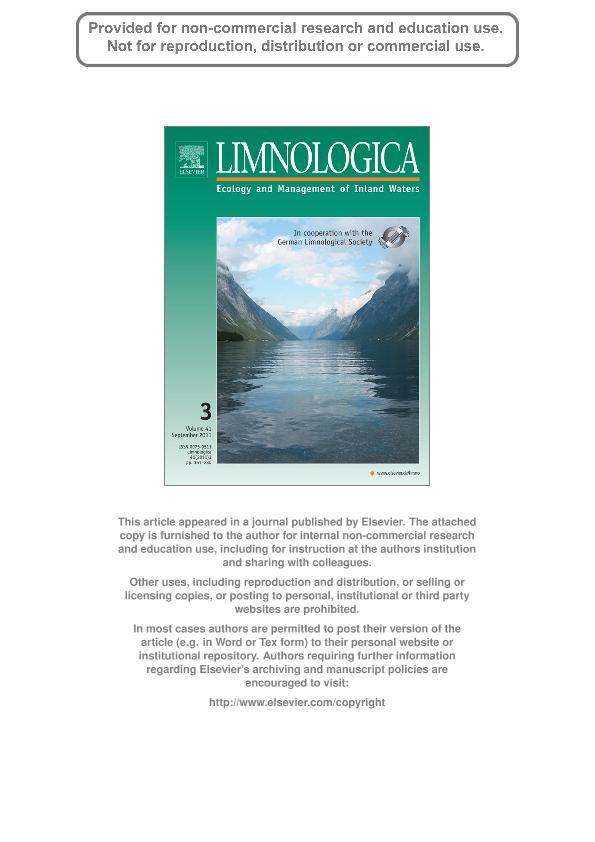Mostrar el registro sencillo del ítem
dc.contributor.author
Silvoso, Julieta

dc.contributor.author
Izaguirre, Irina

dc.contributor.author
Allende, Luz

dc.date.available
2019-01-25T22:35:49Z
dc.date.issued
2011-09
dc.identifier.citation
Silvoso, Julieta; Izaguirre, Irina; Allende, Luz; Picoplankton structure in clear and turbid eutrophic shallow lakes: A seasonal study; Elsevier Gmbh; Limnologica; 41; 3; 9-2011; 181-190
dc.identifier.issn
0075-9511
dc.identifier.uri
http://hdl.handle.net/11336/68703
dc.description.abstract
The relative abundance of the different picoplankton components (eukaryotic picophytoplankton (Peuk), picocyanobacteria (Pcy) and bacterioplankton), and their relationships with the lake conditions were studied in three types of shallow lakes from the Pampa Plain (Argentina) that differ in their optical properties: clear-vegetated, phytoplankton-turbid and inorganic-turbid. All the selected lakes, but one, are characterized by their different alternative steady state (clear-vegetated and phytoplankton-turbid water phases) following the model proposed by Scheffer et al. (1993).Autotrophic and heterotrophic picoplankton abundances were analyzed seasonally in relation to environmental variables. All the lakes presented high concentrations of total nitrogen (TN) (>229μgL-1), total phosphorus (TP) (>46μgL-1) and dissolved organic carbon (DOC) (>13.7mgL-1). Clear-vegetated lakes were characterized by vertical diffuse PAR (photosynthetic active radiation) attenuation coefficient (kdPAR) lower than 11m-1, whereas inorganic-turbid lake always showed values higher than 21.1m-1. The euphotic zone depth (Z1%) was wider in clear-vegetated lakes (40-140cm) and thinner in the inorganic-turbid (10-20cm). The phytoplankton-turbid lakes presented a wide range in the values of these variables (kdPAR: 5.2-35.8m-1; Z1%: 10-90cm). Phytoplankton chlorophyll-a (Chl-a) strongly differed, ranging from 1.6 to 334.6μgL-1. Picophytoplankton was mainly represented by phycocianine-rich (PC-rich) Pcy in all cases, dominating over Peuk algae. The total and relative abundances of eukaryotic picophytoplankton, Pcy and bacterioplankton, as well as the size structure of the phytoplankton community differed among the water bodies. In general, clear-vegetated water bodies exhibited similar abiotic characteristics, picophytoplankton/bacterioplankton ratios, and phytoplankton size structure. Contrarily, no clear trend was identified for the group of turbid lakes. The contrasting results obtained for the importance of the picoplankton components in phytoplankton-turbid shallow lakes evidence that the availability of the energetical and nutrient resources cannot be solely considered to predict their relative importance in this type of shallow lake.
dc.format
application/pdf
dc.language.iso
eng
dc.publisher
Elsevier Gmbh

dc.rights
info:eu-repo/semantics/openAccess
dc.rights.uri
https://creativecommons.org/licenses/by-nc-sa/2.5/ar/
dc.subject
Eutrophic
dc.subject
Picoplankton
dc.subject
Seasonality
dc.subject
Shallow Lakes
dc.subject
Turbidity
dc.subject.classification
Otras Ciencias Biológicas

dc.subject.classification
Ciencias Biológicas

dc.subject.classification
CIENCIAS NATURALES Y EXACTAS

dc.title
Picoplankton structure in clear and turbid eutrophic shallow lakes: A seasonal study
dc.type
info:eu-repo/semantics/article
dc.type
info:ar-repo/semantics/artículo
dc.type
info:eu-repo/semantics/publishedVersion
dc.date.updated
2019-01-25T13:36:21Z
dc.journal.volume
41
dc.journal.number
3
dc.journal.pagination
181-190
dc.journal.pais
Alemania

dc.journal.ciudad
Munich
dc.description.fil
Fil: Silvoso, Julieta. Universidad de Buenos Aires. Facultad de Ciencias Exactas y Naturales. Departamento de Ecología, Genética y Evolución; Argentina
dc.description.fil
Fil: Izaguirre, Irina. Consejo Nacional de Investigaciones Científicas y Técnicas. Oficina de Coordinación Administrativa Ciudad Universitaria. Instituto de Ecología, Genética y Evolución de Buenos Aires. Universidad de Buenos Aires. Facultad de Ciencias Exactas y Naturales. Instituto de Ecología, Genética y Evolución de Buenos Aires; Argentina. Universidad de Buenos Aires. Facultad de Ciencias Exactas y Naturales. Departamento de Ecología, Genética y Evolución; Argentina
dc.description.fil
Fil: Allende, Luz. Consejo Nacional de Investigaciones Científicas y Técnicas. Oficina de Coordinación Administrativa Ciudad Universitaria. Instituto de Ecología, Genética y Evolución de Buenos Aires. Universidad de Buenos Aires. Facultad de Ciencias Exactas y Naturales. Instituto de Ecología, Genética y Evolución de Buenos Aires; Argentina. Universidad de Buenos Aires. Facultad de Ciencias Exactas y Naturales. Departamento de Ecología, Genética y Evolución; Argentina
dc.journal.title
Limnologica

dc.relation.alternativeid
info:eu-repo/semantics/altIdentifier/url/https://www.sciencedirect.com/science/article/pii/S0075951110000575
dc.relation.alternativeid
info:eu-repo/semantics/altIdentifier/doi/http://dx.doi.org/10.1016/j.limno.2010.10.001
Archivos asociados
